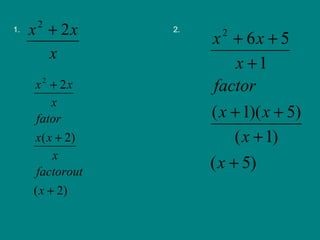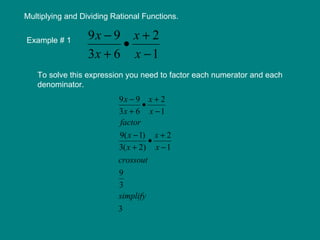Rational functions 13.1 13.2
- 1. Rational Functions Module 13 Overview Topic 13.1 Introduction to Rational Functions Graphing Rational Functions Vertical and Horizontal Asymptotes Topic 13.2 Multiplying and Dividing Rational Functions
- 2. A rational functions is a functions that can be written in the form of a polynomial divided by a polynomial. Where q(x) can not equal zero. Examples: 1. 2. 3. 4. Simplify each expression.
- 3. 1. 2.
- 4. 4. 3.
- 5. A graph of a rational function has a vertical asymptote at each value A where the denominator is 0, and the numerator is not 0. To find the vertical asymptote or asymptotes set the denominator equal to 0 and solve. Vertical asymptotes are vertical lines x = A. Horizontal asymptotes are found by the comparing the degrees of The numerator and denominator. The numerator and denominator are polynomials in x of degree n and m, respectively. If n<m, then y = 0 is the horizontal asymptote. If n = m , then Is the horizontal asymptote. 3. If n > m, there is no horizontal asymptote.
- 6. Graphing Rational Expressions. Find the Vertical and Horizontal Asymptotes. State the domain and range. Example # 1 Set the denominator equal to 0. There are two vertical asymptotes for this function x = 0 and x = 2.
- 7. To find the horizontal asymptote compare the degree of the numerator to the degree of the denominator. The numerator is greater therefore the Horizontal asymptote is y = 0. Now lets graph it. Type the equation and be sure to ( ) around the denominator. It might be hard to see the vertical asymptote. Go to the table and look at the x and y values. Where the Error is are Vertical Asym.
- 8. It is your turn. Graph the following and state the asymptotes if they occur And state the domain and range.
- 9. Set the denominator equal to zero. Two vertical Asymptotes x = 4 and x = -1. The horizontal Asymptotes is y = 0 because the degree of the Bottom is bigger. Now the graph is below.
- 10. Multiplying and Dividing Rational Functions. Example # 1 To solve this expression you need to factor each numerator and each denominator.
- 11. Division To solve use same, change, flip method.
- 12. Now try these problems. 1. 2.
- 13. Solutions
- 14. Solution
- 15. Questions:















